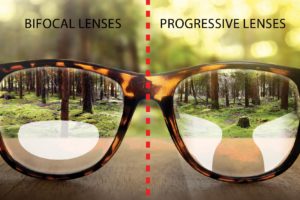February 1, 2022
By Rebecca Yan Shun Weng, BOptom (Hons), GradCert OcTher, GradDip I&T, NAATI (Translator), Brien Holden Vision Institute
Executive bifocals and PALs remain the most accessible myopia control treatment options in many countries, are proven safe and well accepted methods in correcting myopic children’s vision, and continue to play a role in myopia management.
 With many myopia management options to select from, there has never been a more exciting time for eye care professionals to practice this specialty. Advancements in lens designs and technology have seen newer spectacle and contact lens designs introduced in the marketplace, and there appear to be many more on the horizon. The myopia control efficacy afforded by the more recent Defocus Incorporated Multiple Segments (DIMS) and Highly Aspherical Lenslets (HAL) spectacle lenses is significant,1-3 and they exceed the efficacy reported by the first-generation bifocal or progressive addition lenses (PALs). Therefore, the question arises as to whether the earlier designs such as bifocals and PALs still play a role in myopia management.
With many myopia management options to select from, there has never been a more exciting time for eye care professionals to practice this specialty. Advancements in lens designs and technology have seen newer spectacle and contact lens designs introduced in the marketplace, and there appear to be many more on the horizon. The myopia control efficacy afforded by the more recent Defocus Incorporated Multiple Segments (DIMS) and Highly Aspherical Lenslets (HAL) spectacle lenses is significant,1-3 and they exceed the efficacy reported by the first-generation bifocal or progressive addition lenses (PALs). Therefore, the question arises as to whether the earlier designs such as bifocals and PALs still play a role in myopia management.
So let us rewind a bit. Bifocals or PALs to manage myopia progression have been around for a while, with bifocal use reported as early as the 1950s.4 The rationale for using bifocals or PALS for myopia control was based on the hypothesis that excessive or extended near work led to accommodative dysfunction (increased accommodative lag), resulting in hyperopic defocus, which in turn was thought to stimulate axial elongation. Therefore, reducing accommodative demand and/or accommodative lag with plus lenses would slow myopia progression.
How Do These Lenses Impact Myopia Progression?
Although the first trial with PALs by Leung and Brown found a significant difference with +2.00D addition PALs,5 later studies found the slowing of myopia with PALs to be small and not clinically relevant (see Table 1 in Wildsoet et al. 2019, BHVI Myopia calculator). An exception was the significant control found with executive bifocal lenses (+1.50D addition with and without 3.00D base-in prism). Overall, myopia control efficacy with bifocal or PALs ranged from 20% to 50%.7 It is possible that factors such as different lens types, add power, lens fitting, population groups, study methodology, etc., have contributed to the differences between studies. More importantly, a poor correlation exists between accommodative lag and myopia progression.8-10 Additionally, in the study with executive bifocals and fast progressing myopic children, myopia control efficacy was most significant with prismatic bifocal for children with lower accommodative lag.11 However, this area remains inconclusive as there is some evidence to the contrary.
The COMET 2 study investigated the treatment effect of +2.00D addition PALs in children exhibiting high accommodative lag and near esophoria. The mean three-year myopia progression was -0.87D and -1.15D in the PAL and single vision groups, respectively — a difference of 0.28D.12 Importantly, more recently, it was suggested that the relative peripheral myopic shift induced by bifocal and PALs, at least in the superior retinal field, could be the responsible mechanism underlying myopia control with these lenses.6,13
Factors such as adaptation and compliance could play a significant role in the efficacy of these lenses as the children are required to look through the near or add portion of the lenses for close viewing. Kowalski et al. looked at the adaptability of myopic children wearing PALs with a modified fitting protocol (i.e., fitting cross 4mm higher than the standard fitting protocol). They concluded children could safely and comfortably wear PALs, and the initial adaptation symptom diminished at the one-month visit.14 However, it is not clear that children consistently used the add portion of the lens and the impact, if any, of compliance or lack thereof on myopia control.
Do These Lenses Still Play a Role in Myopia Control?
Firstly, although the efficacy of myopia control spectacles is reported as a percentage reduction compared to control single vision spectacles, the figure represents the mean difference in progression between the test and control groups. It is quite likely that some children may have derived greater benefit with the use of the lenses compared to the others.
Secondly, a recent meta-analysis by Haarman et al. indicated that any degree of myopia would impact the likelihood of developing ocular complications.15 Bullimore et al. stated that a 1.00D increase in myopia is associated with a 67% increase in the prevalence of myopic maculopathy.16 These data suggest that any mechanism by which we can slow myopia has benefits.
Additionally, factors such as availability, cost, patient acceptance, adaptation, patient history for progression, non-responsiveness, use of combination therapy (for example, use with higher concentrations of atropine) are likely to play a role in selection and survival in myopia control strategies. Given the above, executive bifocals and PALs should be considered in the eye care practitioners’ toolkit.
Tips for Prescribing Bifocals/PALs for Myopia Control
- If contemplating higher ADD powers for myopia management, the balance between myopia control and functional vision needs to be considered. If the patient cannot tolerate the lens, it is unlikely they will wear these lenses for long.
- Compliance with viewing/performing near tasks through the add portion is essential for treatment efficacy. Therefore, lens fitting plays a critical role in managing treatment efficacy. Ideally, the fitting protocol for either bifocals or PALs should be modified to encourage the child to use the new ADD (i.e., allow maximum access to the treatment zone) without compromising their distance vision. The child will likely receive treatment more effectively if the treatment zone is maximized.
- A follow-up visit early in the process will allow any issues to be managed appropriately and the child/parent trained in the appropriate use of the device.
In summary, executive bifocals and PALs remain the most accessible myopia control treatment options in many countries, are proven safe and well accepted methods in correcting myopic children’s vision, and continue to play a role in myopia management.
 |
Rebecca Yan Shun Weng, BOptom (Hons), GradCert OcTher, GradDip I&T, NAATI (Translator) is a Project Director with BHVI. Her areas of interest are myopia, contact lenses, clinical trials, and partnership engagement. |
References
- Lam, C. S. Y., Tang, W. C., Tse, D. Y. Y., Lee, R. P. K., Chun, R. K. M., Hasegawa, K., … & To, C. H. (2020). Defocus Incorporated Multiple Segments (DIMS) spectacle lenses slow myopia progression: a 2-year randomised clinical trial. British Journal of Ophthalmology, 104(3), 363-368.
- Bao, J., Yang, A., Huang, Y., Li, X., Pan, Y., Ding, C., … & Chen, H. (2021). One-year myopia control efficacy of spectacle lenses with aspherical lenslets. British Journal of Ophthalmology.
- Bao, J., Huang, Y., Li, X., Yang, A., Lim, E. W., Spiegel, D., … & Chen, H. (2021). Myopia control with spectacle lenses with aspherical lenslets: a 2-year randomized clinical trial. Investigative Ophthalmology & Visual Science, 62(8), 2888-2888.
- Mandell, R. B. (1959). Myopia control with bifocal correction. Am J Optom Arch Am Acad Optom, 36, 652-658.
- Leung, J. T., & Brown, B. (1999). Progression of myopia in Hong Kong Chinese schoolchildren is slowed by wearing progressive lenses. Optometry and vision science: official publication of the American Academy of Optometry, 76(6), 346-354.
- Christine F. Wildsoet, Audrey Chia, Pauline Cho, Jeremy A. Guggenheim, Jan Roelof Polling, Scott Read, Padmaja Sankaridurg, Seang-Mei Saw, Klaus Trier, Jeffrey J. Walline, Pei-Chang Wu, James S. Wolffsohn; IMI – Interventions for Controlling Myopia Onset and Progression Report. Invest. Ophthalmol. Vis. Sci.2019;60(3):M106-M131. doi:10.1167/iovs.18-25958.
- Kate L. Gifford, Kathryn Richdale, Pauline Kang, Thomas A. Aller, Carly S. Lam, Y. Maria Liu, Langis Michaud, Jeroen Mulder, Janis B. Orr, Kathryn A. Rose, Kathryn J. Saunders, Dirk Seidel, J. Willem L. Tideman, Padmaja Sankaridurg; IMI – Clinical Management Guidelines Report. Invest. Ophthalmol. Vis. Sci.2019;60(3):M184-M203. doi:10.1167/iovs.18-25977.
- Mutti, D. O., Mitchell, G. L., Hayes, J. R., Jones, L. A., Moeschberger, M. L., Cotter, S. A., … & CLEERE Study Group. (2006). Accommodative lag before and after the onset of myopia. Investigative ophthalmology & visual science, 47(3), 837-846.
- Koomson, N. Y., Amedo, A. O., Opoku-Baah, C., Ampeh, P. B., Ankamah, E., & Bonsu, K. (2016). Relationship between reduced accommodative lag and myopia progression. Optometry and Vision Science, 93(7), 683-691.
- Berntsen, D. A., Sinnott, L. T., Mutti, D. O., Zadnik, K., & CLEERE Study Group. (2011). Accommodative lag and juvenile-onset myopia progression in children wearing refractive correction. Vision research, 51(9), 1039-1046.
- Cheng, D., Woo, G. C., Drobe, B., & Schmid, K. L. (2014). Effect of bifocal and prismatic bifocal spectacles on myopia progression in children: three-year results of a randomized clinical trial. JAMA ophthalmology, 132(3), 258-264.
- Correction of Myopia Evaluation Trial 2 Study Group for the Pediatric Eye Disease Investigator Group. (2011). Progressive-addition lenses versus single-vision lenses for slowing progression of myopia in children with high accommodative lag and near esophoria. Investigative ophthalmology & visual science, 52(5), 2749-2757.
- Berntsen DA, Barr CD, Mutti DO, Zadnik K. Peripheral defocus and myopia progression in myopic children randomly assigned to wear single vision and progressive addition lenses. Invest Ophthalmol Vis Sci. 2013;54:5761–5770.
- Kowalski, P. M., Wang, Y., Owens, R. E., Bolden, J., Smith, J. B., & Hyman, L. (2005). Adaptability of myopic children to progressive addition lenses with a modified fitting protocol in the Correction of Myopia Evaluation Trial (COMET). Optometry and vision science, 82(4), 328-337.
- Haarman, A. E., Enthoven, C. A., Tideman, J. W. L., Tedja, M. S., Verhoeven, V. J., & Klaver, C. C. (2020). The complications of myopia: a review and meta-analysis. Investigative ophthalmology & visual science, 61(4), 49-49.
- Bullimore, M. A., & Brennan, N. A. (2019). Myopia control: why each diopter matters. Optometry and Vision Science, 96(6), 463-465.













